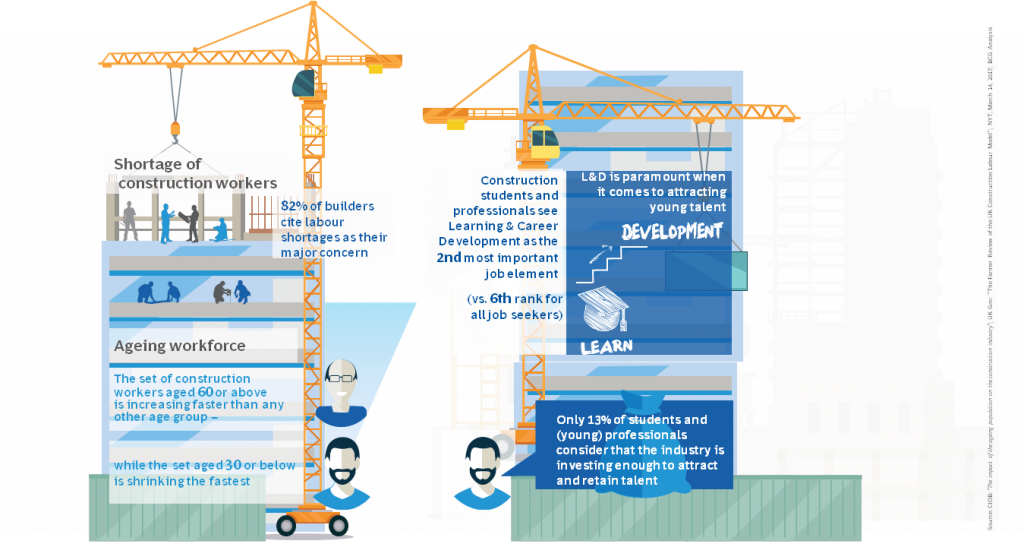Eight ways to win the fight for talent in construction
[edit] Why talent should be a top priority for construction companies
Reflecting on the construction industry as a whole, Brendan Bechtel, Chairman and CEO of Bechtel Group, says:
“Ours is a people business that depends on fielding the most capable project teams in the world.”
In the struggle to recruit and retain talent, he recently revised his strategy, with an emphasis on greater transparency in communication:
“In an increasingly competitive environment, we need to be able to attract the best engineers and managers in order to thrive. Today those elite recruits demand to understand our values, and we need to meet that demand.”
Enlisting and managing talent has long been a challenge for the construction sector, and is sure to become more so in the years ahead, as it will for many other industries.
A recent World Economic Forum report warns how troublesome the coming employment trends might prove:
- The continuing volatility of workforce demand and composition;
- The scarcity of skilled labour, driven by demographic shifts; and
- The demand for new and broader skill sets at all levels, driven by the surging sophistication of technology.
Recent survey results confirm these fears. According to the US National Association of Homebuilders, 82% of construction companies consider their main concern to be the shortage of construction workers.
Sure enough, figures show that the average age of the workforce is rising faster than ever: the UK Chartered Institute of Building (CIOB) reports that the set of workers over 60 is increasing faster, and the set under 30 is decreasing faster, than any other set.
In a recent construction-industry survey conducted for the World Economic Forum, with more than 100 respondents, 77% of respondents agreed that the industry is not doing enough to attract and retain talent, and not one of the respondents fully agreed that the industry is investing enough in recruiting and retaining talent.
[edit] What should the industry do to attract more talent?
Here are eight key actions that construction executives can take to boost their recruitment and development of talent.
[edit] 1. Make talent management a strategic priority
Traditionally, workforce management in construction was equivalent to living a boom-to-bust cycle: hiring and firing followed the general trend of the economy. Winning the war for talent, however, requires a fundamentally different and longer-term approach.
The first step involves strategic workforce planning, i.e. thinking strategically about the company’s future demand in terms of quantity and quality of skills, and the likely availability of those skills to systematically plan recruitment, retention and training.
One quick look at the demographics of the construction industry, and it can be seen how important planning is: the average age of construction workers in the US is 43; in the UK, 700,000 additional construction workers are needed over the next five years to meet the government’s objective of 1 million homes, according to the Farmer report.
The concerns are not just about the quantity but also the quality of the skilled future workforce.
The construction industry is undergoing a rapid digital transformation – through disruptive technologies such as Building Information Modelling (BIM), wireless sensing, big data and analytics, 3D printing, and autonomous equipment – which requires radically different skill sets, and sets the industry in competition with tech companies such as Google or Apple for data scientists and IT experts.
For construction CEOs, people and talent management has to become a top priority, because for students and young professionals it is already a key factor in their choice of employer.
[edit] 2. Rejuvenate corporate culture
When Elon Musk, exasperated by the traffic in Los Angeles, tweeted his intention to develop a tunnel-boring machine and create underground roadways, many people would have dismissed it as 'yet another crazy idea coming out of Silicon Valley'. Some construction-industry participants, though, including the German tunnel-boring specialist Herrenknecht, took it far more seriously.
By setting out a bold vision and creating a culture that is undaunted by tradition, Musk and other successful innovators manage to attract the best talent from very different fields and to defy standard industry practice. In contrast, many or most construction companies are characterised by a conservative, ‘fear of failure’ corporate culture and hampered by organisational inertia.
Culture is a talent magnet, and construction companies need to implement a corporate culture that challenges the status quo and embraces innovation wholeheartedly. One example: some firms have started to break down the traditional hierarchies by means of 'reverse mentoring', i.e. assigning young employees the task of mentoring established executives.
[edit] 3. Invest in diversity
'Pale, male, stale' is so old-fashioned. Yet that kind of workforce persists widely in the construction industry: male employees with an engineering background still predominate, despite the demographic changes and the industry’s digital transformation. Construction companies really need to tap into non-traditional pools – community specialists, women, those with backgrounds in tech or IT or data science.
A recent study by The Boston Consulting Group found a clear link between workforce diversity and innovation – mixed teams with diverse industry backgrounds and career paths tend to make a particularly powerful impact.
As the construction industry continues its tech-driven transformation, it increasingly needs different and more flexible skill sets, and companies need to hire on the basis not just of existing skills but also of potential.
[edit] 4. Leverage technology and innovation
By embracing innovation and new technologies, construction companies can not only make themselves future-ready but can also meet the talent challenge. Increased automation, off-site prefabrication, new collaboration tools – such advances will help to enhance productivity (and wages) as well as reduce the time spent on site – two key wishes for the respondents in our industry survey.
Some innovations that are now standard in the automotive industry – exoskeletons, human-robot collaboration and ergonomic work processes – could benefit construction work too, making it less physically demanding and better suited to an ageing workforce.
[edit] 5. Foster continuous learning and career development
The World Economic Study survey revealed that for students and young professionals, one of the most appealing aspects of a potential job (second only to interesting job content) is learning and career development (L&D).
Yet only 48% percent of respondents found that the construction industry fulfils their expectations in that regard. Continuous L&D is particularly important in a radically changing industry environment that requires different skills.
Construction companies should be integrating continuous L&D into their culture, whether through internal academies, partnerships with external training institutions, or both.
[edit] 6. Create relevant incentives
No commentary on the subject of talent would be complete without some reference to the different priorities of generations Y or Z.
Today’s young talents look beyond salary packages and benefits, and emphasise flexibility ('own your time'), purpose and ethics. Many companies in the tech sector and others have already adapted their recruitment and retention schemes to reflect those new priorities; construction companies need to up their game if they are to compete in the quest for talent. A millennial might well be attracted by the opportunity to help transform a millennia-old industry – but only if he or she feels that the company is genuinely embracing the change.
[edit] 7. Redefine the public image of construction
Construction still has a 'dull and dirty' image currently, but companies are well positioned to create a more appealing image – one of a dynamic and purpose-driven industry. In our survey, industry professionals proudly cited their beneficial impact on society ('we build things'), their contribution to national development, and their engagement with some of the serious modern challenges such as urbanisation and climate change.
It is true, construction accounts for 6% of global GDP, creates the physical milieu for all other industries to flourish, and directly affects everybody’s quality of life through social infrastructure such as housing, hospitals, transport systems, schools and theatres. What is more, built structures and engineering achievements – whether the Egyptian pyramids, the Roman Colosseum, the Panama Canal, or skyscrapers like the Burj [1]Khalifa – have always fascinated people, and continue to do so.
Construction stakeholders should collaborate more in communicating this impact, and should relay their fascinating stories more broadly by means of social media. Companies should start early, and go out to schools and universities to actively shape the image of the industry.
[edit] 8. Collaborate systematically
The seven actions listed so far may take some time to implement, and will certainly take some time to succeed. They require a shift in paradigm, spanning the entire construction ecosystem. One crucial facilitator will be collaboration between companies – to leverage synergies and coordinate campaigns.
Collaboration with external organisations is likewise crucial – with universities, for instance, in providing continuous L&D for construction professionals and in tailoring curricula to the future needs of the industry. One striking example, leveraging the new format of Massive Open Online Courses (MOOCs), is Columbia University’s Construction Project Management and Planning Specialization, which brings together 20 industry leaders from different companies.
[edit] Conclusion
The various actions will require a firm commitment from industry stakeholders, and often a considerable financial investment too. As always, any investment should be based on a clear strategy, and should be prepared carefully in order to pay off in the future. Failing to make a generous investment in talent would definitely be shortsighted.
In the words of Peter Drucker: “Developing talent is business’s most important task – the sine qua non of competition in a knowledge economy.”
Source: Future of Construction Industry Attractiveness web survey among professionals, young professionals and students (October 2016–February 2017).
Written by:
- Santiago Castagnino, Partner & Managing Director, The Boston Consulting Group.
- Ibrahim S. Odeh, Founding Director, Global Leaders in Construction Management – Research Initiative, Columbia University.
- Michael Buehler, Head of Infrastructure and Urban Development, World Economic Forum.
This article was originally published on the Future of Construction Knowledge Sharing Platform and the WEF Agenda Blog.
[edit] Related articles on Designing Buildings Wiki
- 10 construction industry trends to watch in 2017.
- Civil engineers shortage.
- Diversity in the construction industry.
- Farmer Review 2016: Modernise or die.
- How the built environment can unlock opportunities for skills.
- Modernise or die - the need for change in construction.
- Order books fill but skills shortages worry contractors.
- Recruiting and retaining talent in the construction industry.
- Skills shortage.
- Skills to build.
- Tackling the construction skills shortage.
- To attract the right talent, offering flexibility and work-life balance will be essential.
--Future of Construction 16:09, 15 Jun 2017 (BST)









